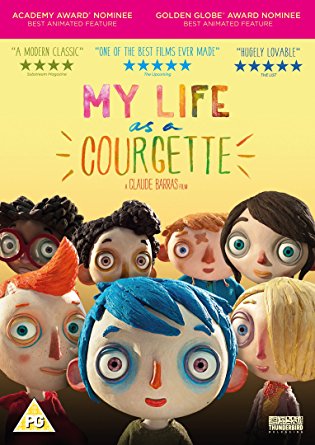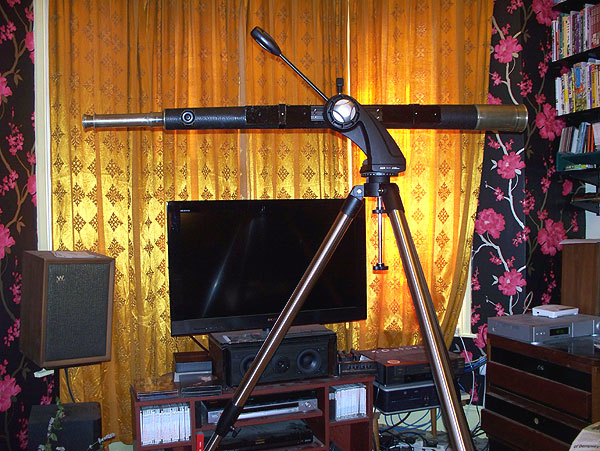Please note that the Anime DB and Manga DB sections of the site are again working. An enforced update of the underlying PHP to a newer and stricter version caused problems with some old code, but these are now fixed. The outage lasted from 26 Apr 2023 to 29 May 2023.
Category: Uncategorized
Anime and Manga database fixed
You can now use the Anime or Manga databases in the menu line as they have been re-coded following an enforced PHP version upgrade.
In the static part of the site, various obsolete pages and links have been removed.
My Life as a Courgette
 ‘Courgette’ is an European stop-motion animated film from director Claude Barras and writer Celine Sciamma. (64 mins) After losing his drunken mother in an unfortunate accident, nine year old Icare, nicknamed ‘Courgette’ is taken to a care home by a kindly policeman. The other kids have equally shocking backstories of abuse and neglect. Courgette has trouble fitting in at first, but a new girl, Camille, arrives whom he recognises as a kindred spirit.
‘Courgette’ is an European stop-motion animated film from director Claude Barras and writer Celine Sciamma. (64 mins) After losing his drunken mother in an unfortunate accident, nine year old Icare, nicknamed ‘Courgette’ is taken to a care home by a kindly policeman. The other kids have equally shocking backstories of abuse and neglect. Courgette has trouble fitting in at first, but a new girl, Camille, arrives whom he recognises as a kindred spirit.
The stylised puppets with their large heads and minimal expressions fit the story. Each child has a distinct character and it is hard not to sympathise with them. Their ill-informed conversations about sex are funny, and the disco scene is one of the highlights of the movie.
For once, the care system and carers get a positive report.
Parents: note that this is PG rated – Disney it’s not.
Highly recommended.
Astronomy revisited.
In the past few months I have become interested again in dabbling with amateur astronomy, prompted by some interesting planetary conjunctions. The observing conditions behind my house are far from ideal, with urban glare and haze making it hard to see stars much fainter than 2nd magnitude, even when it’s not cloudy.
For the past few years I have had a “Skylux” 70-700 refracting telescope that I bought at Lidl. The supermarket chain offer these scopes seasonally, and they are a great bargain. The current offering, branded ‘Bresser’ costs around £50-£60, for which you get a complete kit including an equatorial stand. If you want a starter scope, get one of these as soon as you see it instore. The mounting is similar to an “EQ2” which costs around £100 on its own. You can’t even buy one upmarket telescope eyepiece for £50, let alone a complete kit. The performance is not too bad, despite the give-away price.
Last month I saw the planet Mercury at its conjunction with Venus, initially with the telescopes, then with the naked eye (a rare sight.)

I decided it needed a serious mount and tripod to make it fit for occasional use. It was a bit of a shock to discover just how much a ‘serious’ mounting for a long & heavy scope was going to cost. An equatorial mount man enough for the job would have been over £200, and that’s without any electric drives. I settled for an AZ-4 mount to make it fit for terrestrial and occasional astronomical use. This was the more expensive version of the AZ-4 with stainless steel legs and weighs 18.5 lbs. I still had to buy an overpriced dovetail plate and make up a mounting saddle for a tapered tube.
Having assembled all this kit, I was able to confirm that the old scope contained some serious optics and I got great views of Mars, Venus, Jupiter and the Moon using a decent Plossl eyepiece. It’t the same aperture (70mm) as the Lidl scope but has a noticeably superior performance.
On the other hand, the Lidl scope is one third the weight, a lot shorter, and does not require such a heavy and expensive stand.
Which goes to show that the brass refractor, once a mainstay of well-heeled amateur astronomy, has become obsolete. Since I last took an interest in such matters, the scene has totally changed, with various manufacturers offering a bewildering array of high-tech scope designs at affordable prices. You can pore over compact, portable, GOTO, refractor, reflector, Maksutov, large aperture, whatever suits your interest and wallet. Nowadays compact Maksutov scopes are quite affordable, as are computerised ‘GOTO’ mountings.
I suspect that a lot of the stuff bought is seriously under-used, judging by the number of ‘Astro Scope, used twice’ ads appearing on Ebay.
NHK World
NHK World is a Japanese news, current affairs and features show from Japan – a Japanese equivalent of BBC World. All material either has English audio or is subtitled in English.
The programmes are often quite interesting. I have recently caught a documentary about the recent fatal tunnel collapse (which revealed that crumbling infrastructure is a large problem), news about a China-Japan naval confrontation, and a weekly show about anime and manga. The latter is “imagine-nation”, (Wednesdays, 11.30 am our time). Programmes are free-to-air (no card or subscription needed).
In the UK you can find NHK World on the BSkyB satellite system (in HD), and on the Freesat satellite system (in HD).
In Europe (including UK) you can get it on satellite from 13 deg.E, 11137H in SD. (There are lots of other satellite channels covering other parts of the globe).
Alternatively, the website at http://www3.nhk.or.jp/nhkworld/ includes a small live feed, and the full TV schedule.
Note: Don’t confuse NHK World with JSTV, which is a Japanese-language subscription service.
Defence Spending good value for money?
Lions, Donkeys and Dinosaurs by Lewis Page, 388pp, Arrow Books.
This is an extremely interesting account of, to quote the book “waste and blundering in the (UK) military”. Page’s argument is, essentially, that although UK defence is adequately funded, the men at the sharp end don’t have the equipment they need because of the high level of waste and inappropriate spending. Continue reading “Defence Spending good value for money?”
Kenwood VR-209 remote not working – fixed!
Today I fixed a long-standing fault in my Kenwood AV amplifier. I was sure the remote control was faulty, but then I found that there is a known common fault with Kenwoods: the infrared sensor (behind the right end of the display viewed from front) develops a dry-joint caused by thermal movement of its 3 legs. The cure is to take the lid off the case and re-solder the sensor legs. You can prove the fault by poking the area with your finger, whereupon the R/C will probably start working.
UK anime fans & Blu-Ray, new digital TVs
I was looking at upgrading my viewing kit. I found that the USA and Japan are Blu-Ray region A, and the UK is region B. It is said to be almost impossible to hack the players. That’s bad news. The good news is that around 50% of anime titles on Blu-Ray are A+B, or region-free. (If you do a Google search you should find some lists of them). It’s also possible to get Blu-Ray players with the DVD side chipped for all-region.
New digital TVs from Sony UK don’t now claim that they display NTSC (an analog format). Good news is that they still display NTSC media via HDMI, RGB SCART or composite, depending on the player, and the results are excellent.
NHK World
Following the earthquake/tsunami disaster last March, I followed the news from Japan on NHK World, broadcast in BSkyB’s satellite system. Latterly, NHK World has dropped off the SD BSkyB system, but it’s still available in HD (channel 507 on Sky boxes), or in SD at 13 deg. E, 11137 H on the European satellites.
If you don’t want to invest in satellite hardware, you can also watch it streamed (rather jerkily) online.
Summer anime 2011 – ending comments
It’s time to say something about the Summer anime season which has just ended. I followed four of the Summer anime series to the end:
I watched:
No.6 – it didn’t quite deliver on the intriguing first episode or the all-action second episode, but it was good enough to keep me watching, just about. I had the feeling that the scriptwriters, having set up the story, didn’t know what to do any more. The final episode leant overmuch on the supernatural and didn’t suspend disbelief so much as throw it off a cliff, but at least contained a suitable amount of destruction.
Usagi Drop – ah, the joy of rearing a cute small child… There wasn’t much of a story, but it didn’t really matter.
Ikoku Meiru no Croisee – a charming series that looked good and otherwise didn’t try too hard for effect. Yune is quite cute and rich girl Alice Blanche is deliciously annoying. Not a lot happened at the end.
Kami-sama no memo-chou (God’s Notepad) – I liked this, it seemed well-scripted, and the format of setting up and solving a mystery in two episodes seemed to work well. I thought that the annoying loli Alice (is this a popular anime name?) deserved to be ignored for 12 episodes, the self-centred brat. And wasn’t the little non-Japanese girl cute? Towards the end of the series something happens that was said to be typical of anime but actually rarely occurs – a major character gets wiped out.
Double-J – I watched about 8 episodes before getting bored with it. Perhaps one needs to be Japanese to really get the joke.
Continued watching to the end, from previous season:
Hanasaku Iroha – I just like this sort of slice-of life melodrama. BTW the title translates as “Personal Growth ABC”. The ending was a mild surprise, and left one wondering if it was a hook for a second series next year.
Steins; Gate – I kept watching to find out if things got more and more messed up or got fixed by the end. I’m not sure if it made sense, but if it didn’t, it wasn’t obvious. I was tickled to discover that some of the whacky stuff in the series wasn’t just made up – Google the ‘IBM 5100’ or ‘John Titor’ and you’ll see what I mean…
I am also watching the excellent Mawaru Penguin Drum which continues for another 12 or so episodes.
